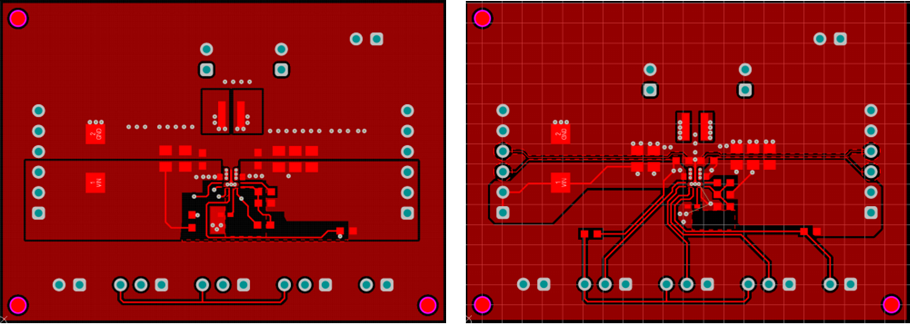-
Layer Design for Reducing Radiated EMI of DC to DC Buck-Boost Converters SLVAEP5A April 2020 – June 2021 LM3668 , TPS63000 , TPS63000-Q1 , TPS63001 , TPS63002 , TPS63010 , TPS63011 , TPS63020 , TPS63020-Q1 , TPS63021 , TPS63024 , TPS630241 , TPS630242 , TPS630250 , TPS630251 , TPS630252 , TPS63027 , TPS63030 , TPS63031 , TPS63036 , TPS63050 , TPS63051 , TPS63060 , TPS63061 , TPS63070 , TPS63802 , TPS63805 , TPS63806 , TPS63810 , TPS63811 , TPS63900 , TPS63901
-
Layer Design for Reducing Radiated EMI of DC to DC Buck-Boost Converters
Layer Design for Reducing Radiated EMI of DC to DC Buck-Boost Converters
Trademarks
All trademarks are the property of their respective owners.
1 Introduction
Meeting clearly defined emission standards is a critical requirement for releasing new products to the market. Today however, almost half of these products end up failing the emission standards. These failures translate to significant delay and can quickly increase the final cost of the product. This report illustrates rule-of-thumb solutions for PCB integration of TPS63xxx that can be implemented to improve EMI performance.
2 EMI Sources
 Figure 2-1 EMI Sources in Non-inverting
Buck-boost Converter
Figure 2-1 EMI Sources in Non-inverting
Buck-boost ConverterFigure 2-1 highlights the main sources of EMI in a non-inverting buck-boost converter.
The first EMI source is the hot loop located between input capacitor (CIN) and SW2. The second loop responsible for EMI is the loop located between output capacitor (COUT) and SW3. The loops occurrence differs dependent on the converter operating mode. In Figure 2-1, the left loop exists during buck mode operation while the right most loop, during boost mode operation. Due to the switching logic, these loops will have high rates of change in current over time (di/dt). Taking into account the equivalent series inductance (ESL) of a capacitor and the equation of voltage over inductor Equation 1, it can be seen that these hot loops can give rise to unwanted voltages (vL).

The switching nodes L1 and L2 are another EMI source. Depending on the operation mode, L1 for buck and L2 for boost, these nodes experience high changes in voltage over time (dv/dt). A change in voltage can give rise to undesired currents in a capacitor as shown by Equation 2. Keeping in mind that capacitances can develop between inductor windings, the occurrence of parasitic currents (i2C) is possible.

Besides the parasitic capacitance of the inductor, another capacitance also exists between the node and the ground layer. This capacitance is described by Equation 3 and it is strongly influenced by the distance (d) between the layer on which the node is located and the closest ground layer as well as by the area of the parallel plates (A). ε0 and εr are the permittivity of free space (ε0=8.85 pF/m) and the relative permittivity of the medium between the two plates.

The following sections will introduce tested solutions that reduce radiations. The proposed solutions are accompanied by measurements that prove their effectiveness. The measurements were conducted in accordance to the CISPR 16-2-3 standards and regulations referenced in Section 7.
3 Device Optimization
Figure 3-1 shows the circuit of a typical application of TPS63070. This circuit is used in this application note. The starting PCB layout concept is the recommended Webench layout for PCB built provided by Texas Instruments.
Please note that the Webench layout is not optimized for best EMI performance, but for the ability to place different size components.
 Figure 3-1 Typical Application of TPS63070
Figure 3-1 Typical Application of TPS63070The Webench PCB layout is a two layer approach. All the planes, except the inductor ports, are kept on the top layer. The bottom layer consists of the inductor terminals and input and output planes. Optimizations can be done to the Webench layout in order to improve the radiated performance as follows:
- Minimizing hot planes: The area size of the nets corresponding to the input, output, inductor and other components connections should be kept as small as the design permits. Maximum area size should be assigned to the ground planes.
- Keeping traces entirely on one layer: Avoid as much as possible crossing between layers in the middle of a trace. This procedure reduces the number of vias and lowers the overall plane inductance.
Figure 3-2 shows the top layers of the Webench layout (left) and the optimized layout (right). It highlights the minimized planes and the lack of cross layer talk.
 Figure 3-2 Top Layers of Webench Layout (left) Optimized Layout (right)
Figure 3-2 Top Layers of Webench Layout (left) Optimized Layout (right)Figure 3-3 shows the benefits of the above mentioned improvements. The difference between the two measurements is significant and easily observable. Numerically, this difference can be as high as 10 dB at the most affected frequencies.
 Figure 3-3 Radiated EMI Response of the Webench Layout and the Optimized Layout
Figure 3-3 Radiated EMI Response of the Webench Layout and the Optimized Layout